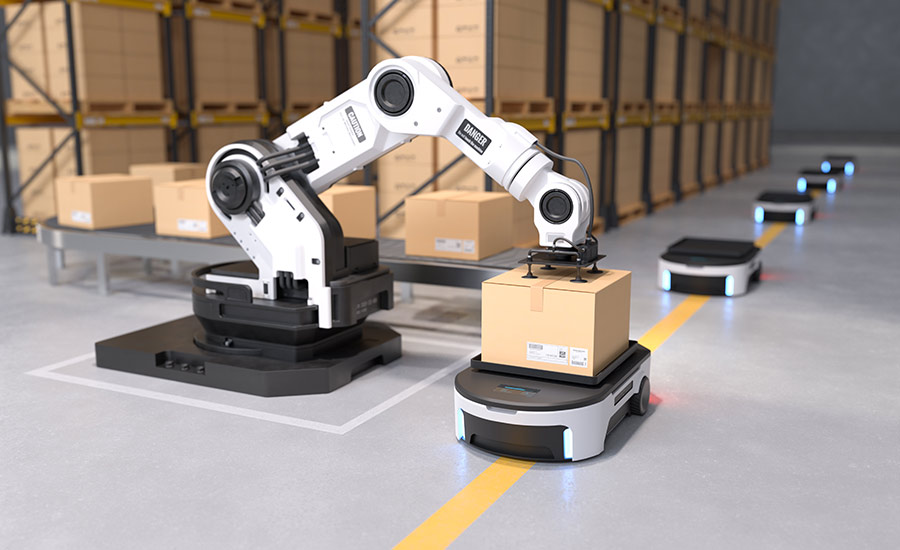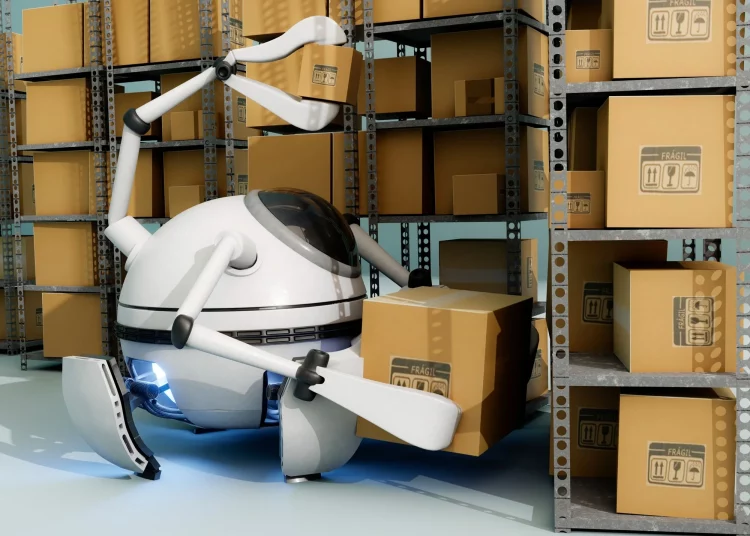Introduction
In today’s fast-paced business environment, efficient inventory management is a critical factor for success. Whether in manufacturing, e-commerce, or retail, companies are constantly striving to streamline their supply chains, reduce waste, and improve their responsiveness to changing market demands. The rise of robotics and real-time data analytics is revolutionizing inventory management, allowing businesses to not only keep track of inventory levels but also predict, optimize, and automate various supply chain processes.
This article explores how robots, powered by real-time data analysis, are transforming inventory management, reducing inventory backlog, and enhancing supply chain efficiency across multiple industries. We will examine the role of robotic systems, automation, and advanced algorithms in reshaping inventory control processes and delivering significant cost-saving and operational benefits.
1. The Importance of Efficient Inventory Management
1.1 The Role of Inventory in Modern Business
Inventory management has always been a central aspect of business operations, directly impacting the cost-effectiveness and efficiency of supply chains. However, in today’s competitive landscape, businesses are expected to manage inventory more dynamically than ever. They must handle fluctuating demand, fast-moving consumer goods, and global supply chains—all while maintaining minimal costs and avoiding disruptions.
Effective inventory management ensures that the right products are available at the right time, reducing the need for overstocking, preventing shortages, and ensuring smooth order fulfillment. Historically, managing inventory has required substantial human labor and manual data entry. But with the advent of robotics and automation, businesses are now able to leverage cutting-edge technologies to manage inventory with unprecedented efficiency.
1.2 Challenges in Traditional Inventory Management
The traditional approaches to inventory management often involve manual counting, time-consuming audits, and reliance on spreadsheets or legacy software systems. This can lead to:
- Stockouts and Overstocking: Lack of real-time visibility can result in inventory imbalances, either overstocking products that don’t sell or understocking those in high demand.
- Inaccurate Data: Manual systems are prone to errors, leading to discrepancies between actual and recorded inventory, making it difficult for companies to rely on inventory data for forecasting and decision-making.
- Inefficiencies in Stock Replenishment: Without automation, businesses can face slow response times when demand surges, and slow-moving inventory can sit on the shelf for extended periods, tying up valuable storage space and capital.
2. Robotics in Inventory Management: A Game-Changer
The integration of robotics and automation in inventory management is reshaping the entire supply chain process. From warehousing to inventory tracking, robots and automated systems are providing significant advantages over traditional methods. These systems not only optimize storage space but also enable real-time data collection and analysis, improving decision-making and operational performance.
2.1 Autonomous Mobile Robots (AMRs)
One of the most impactful types of robots in inventory management are Autonomous Mobile Robots (AMRs). These robots are designed to move independently across a warehouse or storage facility, assisting with tasks such as:
- Material Handling: AMRs can transport inventory from one location to another, removing the need for human workers to manually move goods.
- Stocking and Restocking: AMRs can identify low-stock items and retrieve products from storage racks to restock inventory automatically.
- Real-time Tracking: Equipped with sensors and cameras, AMRs can provide real-time inventory updates, allowing managers to track inventory levels instantly.
The ability of AMRs to navigate autonomously allows them to adapt to complex warehouse environments, significantly improving operational efficiency while minimizing human labor and errors.
2.2 Automated Guided Vehicles (AGVs)
Automated Guided Vehicles (AGVs) are another type of robot used in warehouses and distribution centers. These vehicles follow predefined paths or use vision systems to navigate the environment and are commonly used for transporting goods between different areas of a warehouse. AGVs are particularly useful for bulk inventory movement, efficiently handling large quantities of materials across long distances within facilities.
AGVs can also integrate with warehouse management systems (WMS) and provide real-time data on the location and status of inventory. This automated system integration ensures a smooth flow of materials, reduces congestion in warehouses, and eliminates the risk of human error in item retrieval.
2.3 Robotic Picking Systems
Robotic picking systems use a combination of robotic arms, vision systems, and AI algorithms to automate the process of retrieving items from shelves or storage areas. These systems can be designed to handle specific tasks, such as:
- Order Fulfillment: Robots can autonomously pick, pack, and prepare orders for shipment, streamlining fulfillment processes and reducing processing times.
- Inventory Audits: Robots can regularly scan shelves, count products, and provide real-time data to the inventory management system, ensuring that stock levels are always accurate.
These robotic systems significantly improve accuracy and speed while lowering labor costs and human error in inventory handling.

3. Real-Time Data Analytics in Inventory Management
The integration of real-time data analytics into robotic systems is transforming how businesses manage their supply chains. By using sensors, cameras, and machine learning algorithms, robots can collect and analyze data from their surroundings in real-time. This information is crucial for optimizing inventory control and improving overall supply chain performance.
3.1 Predictive Analytics and Demand Forecasting
One of the key benefits of real-time data analytics is the ability to leverage predictive analytics to forecast future demand. By analyzing historical sales data, seasonal trends, and external factors such as market shifts or economic changes, companies can:
- Optimize Stock Levels: Predictive models can calculate the ideal stock levels for each item, helping businesses avoid stockouts and overstocking situations.
- Improve Replenishment Cycles: Real-time data enables businesses to replenish inventory just in time to meet demand, avoiding unnecessary storage costs.
3.2 Inventory Visibility and Tracking
Real-time data allows businesses to monitor and track inventory throughout the entire supply chain. Using technologies such as RFID, GPS tracking, and barcodes, companies can achieve complete visibility into the movement of goods. This enables:
- Accurate Stock Levels: Continuous tracking of inventory across various stages of the supply chain ensures accurate and up-to-date data.
- Optimized Routing: Real-time tracking helps companies optimize the routes that robots take to retrieve or transport inventory, reducing delays and improving operational efficiency.
- Reduced Wastage: By accurately tracking inventory levels and expiration dates (in sectors like food and pharmaceuticals), businesses can minimize waste and avoid losses.
3.3 Real-Time Decision Making
With real-time data, businesses can make informed decisions faster than ever before. Whether it’s restocking shelves, adjusting order fulfillment strategies, or redistributing inventory across various warehouses, robots powered by real-time analytics enable companies to respond to market changes almost instantaneously.
The ability to react to shifting consumer preferences or unexpected disruptions—such as stock shortages or supply chain delays—becomes a crucial competitive advantage in an ever-changing marketplace.
4. Benefits of Robotics and Real-Time Data in Inventory Management
The integration of robots and real-time data analytics offers a range of benefits for businesses:
4.1 Increased Efficiency and Productivity
By automating time-consuming tasks, robots significantly increase the speed and efficiency of inventory management. Tasks such as restocking, sorting, and item retrieval can be completed faster, allowing businesses to handle more products in less time.
4.2 Cost Savings
Robotics reduces the need for manual labor, lowering labor costs and decreasing the likelihood of human errors. Furthermore, the real-time data collected by robots helps optimize inventory levels, preventing overstocking or stockouts, both of which can lead to costly inefficiencies.
4.3 Enhanced Accuracy and Reduced Errors
Manual inventory management is prone to errors, whether from human oversight, miscounting, or incorrect data entry. With robots, the entire process becomes more accurate, as robotic systems follow predefined instructions and use advanced sensors and vision systems to collect data, ensuring inventory accuracy at all times.
4.4 Scalability and Flexibility
As businesses grow, managing inventory across multiple locations or scaling operations to meet rising demand becomes increasingly complex. Robots, however, offer unparalleled scalability. With minimal additional investment, businesses can expand their robotic fleet and systems to handle larger volumes of inventory and adapt to changing operational needs.
5. Future Outlook: The Evolution of Robotics in Inventory Management
5.1 Advancements in AI and Machine Learning
The future of robotics in inventory management is intertwined with the advancements in AI and machine learning. As these technologies become more sophisticated, robots will continue to improve in their ability to anticipate demand, optimize workflows, and learn from past experiences, further enhancing their efficiency and intelligence.
5.2 Integration with Blockchain and IoT
As blockchain and Internet of Things (IoT) technologies continue to evolve, they will provide even greater transparency and traceability for inventory management. Blockchain can offer secure, transparent tracking of goods through the supply chain, while IoT-enabled devices will provide even more detailed, real-time data about inventory conditions and movement.
Conclusion
The integration of robotics and real-time data analytics in inventory management is helping businesses achieve unprecedented levels of efficiency, accuracy, and cost-effectiveness. By automating repetitive tasks, enhancing inventory visibility, and optimizing supply chain processes, robots are changing the way businesses manage their inventory. As technology continues to advance, we can expect robots to play an even larger role in shaping the future of inventory management, ensuring businesses remain competitive in an increasingly demanding market.







































